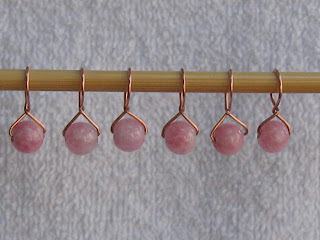
everythingshunkydory
... a little bit of knitting ... a little bit of jewelry making
Wednesday, February 24, 2010
Monday, February 15, 2010
Monday, February 8, 2010
Saturday, December 27, 2008
Falling Leaves Wrap
This rectangular wrap is just the thing for a cool summer evening or to take the chill off in an over-air-conditioned restaurant or office. The original was knit in a merino yarn which is soft and lightweight. It’s sproingy, wonderful to knit with and blocks beautifully. Gauge isn’t critical because the wrap can be blocked to your desired dimensions. The pattern can easily be changed to accommodate different yarn weights by adjusting the size of the knitting needles used and by working fewer or more pattern repeats horizontally and vertically. The 16 row pattern isn’t daunting; after you’ve completed a 16 row pattern, you should be able to visualize what the stitches on each row are "doing" and you can easily find your place should you lose your row count.
Approximately 24"wide x 66" long (60 cm x 170 cm) after blocking.
Yarn: 2 skeins Colinette Jitterbug (640 yards) (585.2 meters) or any merino wool that you love the feel of.
Needles: U.S. size 6 (4 mm.)
Cast on 83 sts. loosely.
Row 1 (RS): K1, k2tog, k3, *yo, k1, yo, k3, sl 1, k2tog, psso, k3; repeat from * to last 7 sts, yo, k1, yo, k3, sl 1, k1, psso, k1.
Row 2 and every alternate even numbered Row: Purl.
Row 3: K1, k2tog, k2, *yo, k3, yo, k2, sl 1, k2tog, psso, k2; repeat from * to last 8 sts, yo, k3, yo, k2, sl 1, k1, psso, k1.
Row 5: K1, k2tog, k1, *yo, k5, yo, k1, sl 1, k2tog, psso, k1; repeat from * to last 9 sts, yo, k5, yo, k1, sl 1, k1, psso, k1.
Row 7: K1, k2tog, yo, k7, *yo, sl 1, k2tog, psso, yo, k7; repeat from * to last3 sts, yo, sl 1, k1, psso, k1.
Row 9: K2, yo, k3, *sl 1, k2tog, psso, k3, yo, k1, yo, k3; repeat from * to last 8 sts, sl 1, k2tog, psso, k3, yo, k2.
Row 11: K3, yo, k2, *sl 1, k2tog, psso, k2, yo, k3, yo, k2; repeat from * to last 8 sts, sl 1, k2tog, psso, k2, yo, k3.
Row 13: K4, yo, k1, *sl 1, k2tog, psso, k1, yo, k5, yo, k1; repeat from * to last 8 sts, sl 1, k2tog, psso, k1, yo, k4.
Row 15: K5, *yo, sl 1, k2tog, psso, yo, k7; repeat from * to last 8 sts, yo, sl 1, k2tog, psso, yo, k5.
Row 16: Purl.
Repeat these 16 Rows until there's not enough yarn left to allow you to complete another 16 Row pattern, making sure to leave enough yarn for 36 strands each 10" long for the fringe. Bind off loosely.
To make fringe: Cut 36 strands of yarn, 10" (25 cm.) long. Attach these at the 9 points at each end of the shawl, by taking 2 strands, folding them in half and pulling the folded end through each point, using a crochet hook if desired. Secure the fringe, by pulling the 4 cut ends through the loop tightly.
To block, place wrap in lukewarm water until thoroughly soaked, being careful not to agitate the fibres. Place between two layers of thick towel and gently press to remove excess moisture. Stretch the wrap into the desired shape, pinning onto a flat surface and allow to dry. Weave in loose ends. Here’s a link to the Yarn Harlot’s technique. It will make the straight edges of the wrap easier to block and then all you have to do is pin the 9 points at each end.
http://www.yarnharlot.ca/blog/archives/2005/08/23/walk_around_the_block.html
Abbreviations used:
sl1 - slip one stitch as if to knit
psso - pass slipped stitch over
Friday, November 23, 2007
Turquoise Cuff
Amethyst Pendant
Friday, August 24, 2007
Egyptian Coils Bracelet

Friday, August 3, 2007
First Time Using a Jig

Friday, July 27, 2007
Baby Booties









